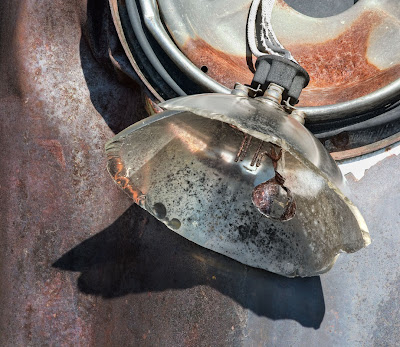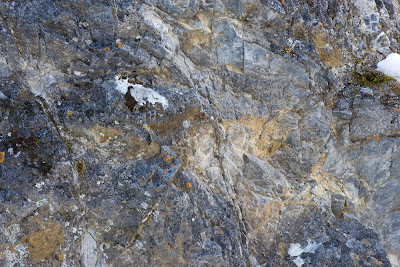
The ability to 'read' photographs is an essential skill on the way to making photographs. I'll not get into a chicken and egg discussion of which comes first, but simply to say that I think that to develop our skill as photographers it is essential to develop facility at reading photographs. it isn't just about seeing the good points of a great photograph, it is a subjective assessment of both the good and the bad about a photograph.
On that note, I'll introduce one of my images upon to base this discussion. It's one I like a lot, though it's never been a popular seller.
What's The Photograph About?
Well, in this case, it's a picture of a broken presumably old headlight (it's perfectly round and the body of the vehicle is very rusted so that makes it fairly old). The subject matter might or might not interest you. If you were into old vehicles, you might wonder what year vehicle, make, model or even what kind of vehicle. Perhaps you'd ask yourself where such a vehicle was found - on the street, in a junk yard or where. Curiosity about the subject of the photograph is an important component of an image - if it doesn't generate any curiosity in anyone, it's failed at a pretty fundamental level. There's also the repeated curves of the inner part of he bulb base, the outer part and that bright white rim around which is actually seen through the glass of the bulb as well as beyond it.
What's The Photograph About At A Deeper Level?
If of a philosphical or analytical bent, you might wonder about what the photograph says about aging, permanence, design, functionality or any number of other aspects of the image. It isn't even necessary for the photographer to have been either aware of those aspects of the image and certainly not to have deliberately inserted them into it. Whether the photographer might have been aware of it at a subconsious level really doesn't matter - if the photograph makes you think, does it matter if the photographer didn't. Can a blind person bake a cake that looks nice? Why not?
What Are The Parts Of The Image, And How Do They Relate?
Well, the hanging and broken headlight is an obvious major part of the image, but so is that dark and interestingly shaped shadow of the bulb sitting below it. Note the filament nicely located over a highlight so it stands out a bit, even though it is quite small. The body of the vehicle has several textures and colours - from fairly rusty to quite smoothe. Note though the colour tie in from almost purple in the rust on the left, to the bluish gray on the right, and the bluish tinge in the glass of the bulb, contrasted with the orangy rust of the headlight socket.
The wires curving down are important, particularly for their bright white. How about the complementary curves of the bulb and the bottom of the circular lamp fitting attached to the body of the vehicle.
Tonalities
Well, there's a painterly look to the image, particularly in the bottom half. The border between the white rim and that light blue on the right looks like it's a painting.
There's enough variation in tonality in the body of the vehicle to provide interest without adding distraction. The dent of the body even provides a bit of a specular highlight in the upper left where we're getting a bit of shine on the rusted metal.
Negative Space
If you look at the shapes surrounding the headlight and it's base, they are quite interesting in and of themselves. If you click on the image to bring it into it's own window, you can reach out with your fist and cover the base and headlight, leaving the shadow and body of the vehicle and still have some intersting shapes and textures, colours and tones.
Balance
The image does seem to be well balanced, with the base in the upper left, the bulb in the middle and it's shadow reaching to the lower left. Note the darker edges in the upper left and lower right, tending to keep one looking towards the centre of the image, almost acting as a frame to the parts of the image arrayed in a bottom left to upper right sequence, opposite of those two dark aeas which are on the opposite diagonal.
Framing
Not much to complain about - the bulb has breathing room - sure we could have cropped to the edges of the bulb, but the background works nicely and gives a hint of the old vehicle so is justified. Would the image have been better had the entire circle of the headlight base been included, or possibly more of the body (fender?) of the vehicle, perhaps even enough to help identify the vehicle? Well, this way it has more of an abstract feeling to it, a wider shot, even if it were well composed, would be more illustrative, certainly not the effect I wanted to portray - I don't give a damn what vehicle it was from, even though the viewer might.
Emotional Impact
Come on guys, it's a picture of a broken headlight, not a grieving widow after a massacre. Still, to me it has a sense of rightness, that things work together. I'd like to think that someone might react with surprise that such an ordinary subject could make an interesting photograph. If the emotional impact is nothing more than 'well, isn't that neat', that's quite sufficient. I don't suppose anyone is going to say that this image altered their lives, but perhaps someone remembers their Dad tinkering with old rusted vehicles, or that beat up old truck on Grandpa's farm you played in as a kid. Did I think of this as I took the picture? No, of course not. We don't even know what Da Vinci was thinking when he painted the smile on Mona Lisa - he may have reacted to it at a gut level rather than an intellectual one. Perhaps he had no idea of all the guesswork he would engender as people over the ages try to figure out what it's about - perhaps she had gas after the spicy sausage at lunch. Doesn't really matter - Da Vinci either saw it or created it from memory, thought it interesting and painted it in.
Flaws
There's not a lot that I'm unhappy with. The white of the wiring and of the surround for the headlight base is glaring white and is in fact pure 255 - overexposed, no detail recoverable. Does it matter - it bothers me, don't know if anyone else is bothered by it. I did use highlight recovery in an early version of Camera Raw - it's possible the latest version might work better, but probably over the top is still over the top. I can live with it. None of my images are perfect in every way. If we only read perfect novels, watched perfect films or listened to perfect music, we wouldn't have much to enjoy - a few masterpieces and we'd quickly run out of material, whatever the medium. It's too bad the filament isn't 10 times bigger but also against a white background so it would really stand out, still there's something to be said for giving persistent viewers more to see after the first cursory look. In fact, I'd say it's essential to give them more. It would be a pretty shallow picture that could be consumed in a glance.






























